An alternative A-Z of gardening for wildlife, regeneration, and wilding, Part 1

For context, the garden is just over 2 acres and we are blessed geographically to be only a stone’s throw from the River Kennett, but even so, I am convinced that most of the some 16 bird species that nest each year in our plot and the nearly 60 species I record each year are down to some of what I write here. I am not a scientist and everything I narrate is through my own findings on what I observe. When we moved here in 2012 there was a muddy path all around the boundary with an electric cable that kept the two Bedlington terriers within the perimeter, a sort of dog racetrack, and like most gardens in 2012 a fairly uniform lawn. A sort of dog racetrack, and like most gardens in 2012 a fairly uniform lawn. There were seven random and very large leylandii trees sucking out the life, light, and soul of the place with a bare lappet fence on the right and a bare barbed wire post and rail fence on the left. My task for you is to pick out something from below.
A is for And - We start with AND. It’s a mindset thing the whole plot is gardening AND nature, I am either gardening directly for nature or with nature in mind, including my kitchen garden, so first it’s important to get your head in gear.
B is for Blossom and Bees – Those big queen buff-tailed bumblebees flying low to the ground in late Winter are not just looking for somewhere to nest they are also hungry. And, with milder winters they wake up earlier. Mahonia (December) winter honeysuckle (January) and pulmonaria and crocuses (February) can help them through the darkest months followed by the earliest fruit trees like damson and pussy willow for it’s pollen. This is like looking after your broodstock
C is for Compost and Cover – How many plastic bags of compost are unnecessarily lugged across our lands, while the empty bags fill our landfill sites. A compost heap is not just a cost-effective way to replenish your soil’s nutrients and improve its structure, it is also a house and home for a multitude of beneficial creatures and no it will not encourage rats, providing you never introduce any cooked produce or meats. I have two, simply made from old wooden pallets. One for adding new material and one I am extracting from. The current season's new pile is home to grass snake eggs every year laid betwixt dried beech leaves I lay on the bottom and the fresh grass cuttings bringing warmth from above. Dotted around the garden are piles of decaying logs, leaf litter and spent herbaceous stems. Stacked neatly they do not appear messy and the long grasses and wildflowers all around create their own mini ecosystems.
D is for Disturbance and Dogs – We see the odd muntjac in the garden and try as I do to discourage them (they eat the tulips and camassia) they just jump the fence from a standing start, but it was only when a neighbours’ spaniel ran into the garden and the childlike cries of a baby muntjac alerted a furious mother to come streaking across three paddocks and two fences did I realise she had decided this was a quiet safe space to be her nursery. We all underestimate the disturbance from pets, while wild animals can become accustomed to us humans. Just the presence of cats and dogs pushes wildlife away, no-kill required, why waste energy on evasion? The dog race track has now healed over.
More in the next blog...

